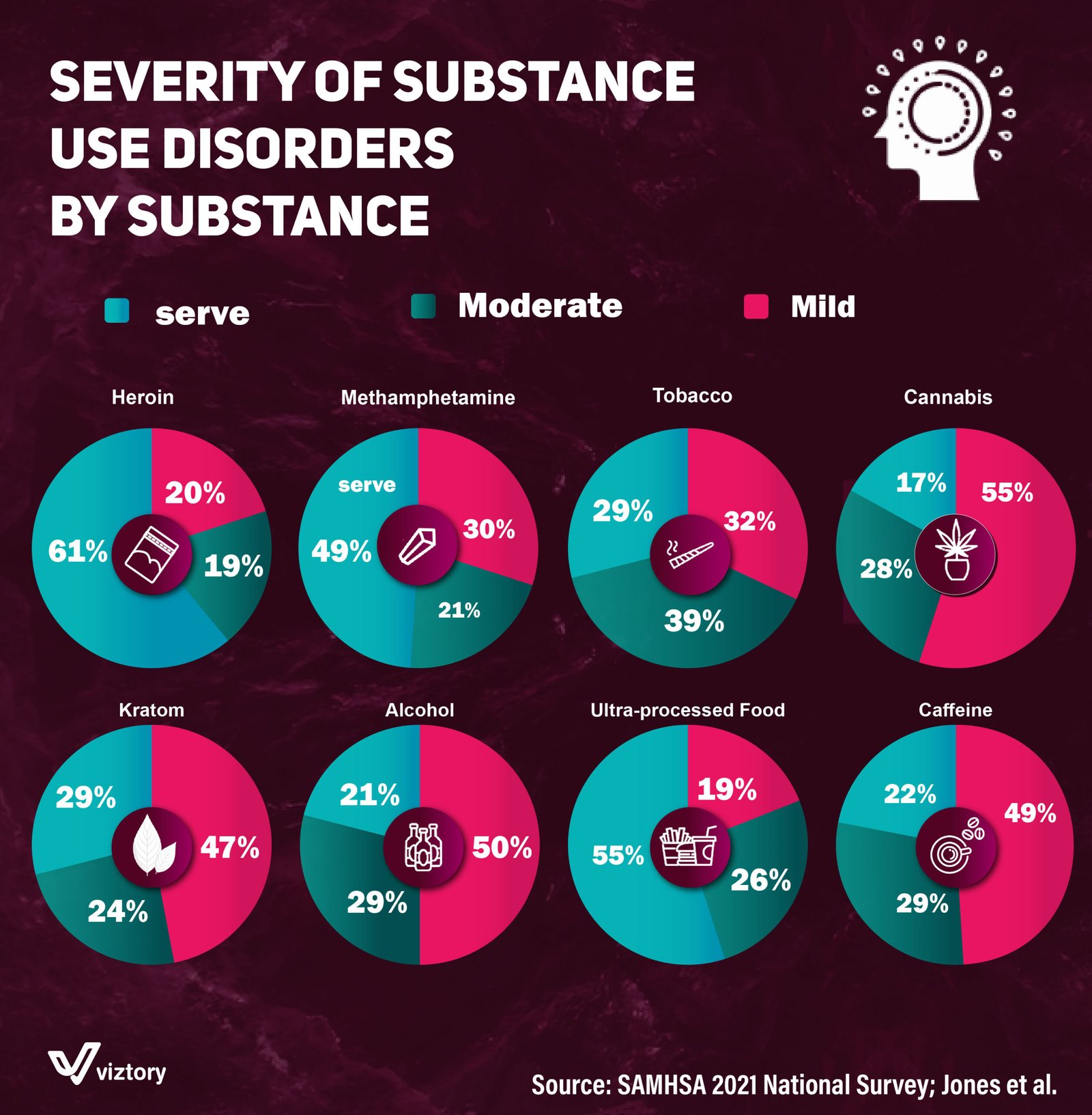Severity of Substance Use Disorders by Substance
-
Nov, Sun, 2024
Substance use disorders (SUDs) pose significant challenges to public health worldwide, affecting individuals’ physical and mental well-being. The infographic provides an overview of the severity of SUDs for various substances, classified into severe, moderate, and mild cases. These insights are crucial for healthcare professionals and policymakers to tailor interventions and allocate resources effectively.
Substance-Specific Insights
Heroin
- Severe Cases: 61%
- Moderate Cases: 20%
- Mild Cases: 19%
Heroin, a potent opioid, has the highest percentage of severe cases among the substances listed. Its addictive nature and high risk of overdose make it a critical focus for healthcare interventions, including harm reduction strategies and medication-assisted treatments (MATs).
Methamphetamine
- Severe Cases: 49%
- Moderate Cases: 30%
- Mild Cases: 21%
Methamphetamine use is associated with severe mental health challenges, including psychosis and cognitive impairments. Treatment programs must combine behavioral therapies with community support to address the long-term impacts.
Tobacco
- Severe Cases: 29%
- Moderate Cases: 39%
- Mild Cases: 32%
Despite its lower association with severe cases, tobacco use remains a leading cause of preventable diseases, including lung cancer and cardiovascular illnesses. Healthcare campaigns targeting smoking cessation, such as nicotine replacement therapies, are critical.
Cannabis
- Severe Cases: 17%
- Moderate Cases: 28%
- Mild Cases: 55%
Cannabis use disorders are predominantly mild but require attention due to their growing prevalence. With the legalization of cannabis in many regions, education on responsible use and early intervention is essential.
Kratom
- Severe Cases: 24%
- Moderate Cases: 29%
- Mild Cases: 47%
Kratom, a plant-based substance, is often marketed as a natural remedy but can lead to dependency. Healthcare providers must be aware of its risks and educate users about potential side effects.
Alcohol
- Severe Cases: 21%
- Moderate Cases: 29%
- Mild Cases: 50%
Alcohol remains one of the most widely used substances, with a high burden on healthcare systems due to liver disease, addiction, and its role in accidents. Comprehensive strategies including counseling, detoxification, and support groups are critical for recovery.
Ultra-Processed Food
- Severe Cases: 19%
- Moderate Cases: 26%
- Mild Cases: 55%
The emerging recognition of ultra-processed food addiction highlights its contribution to obesity and related chronic diseases. Public health campaigns promoting healthy eating and regulating food marketing are necessary to combat this issue.
Caffeine
- Severe Cases: 22%
- Moderate Cases: 29%
- Mild Cases: 49%
Although often overlooked, excessive caffeine consumption can lead to dependency and health issues such as anxiety and insomnia. Awareness campaigns and moderation strategies can help mitigate risks.
Healthcare Strategies for Addressing SUDs
Early Detection and Screening Regular screening in healthcare settings can identify substance use patterns early, enabling timely intervention and reducing the risk of severe disorders.
Integrated Treatment Programs Combining medical, psychological, and social support ensures comprehensive care for individuals with SUDs. Integrated approaches like MATs for opioid addiction or cognitive-behavioral therapy (CBT) for methamphetamine use can improve outcomes.
Community and Family Support Engaging families and communities in recovery efforts creates a supportive environment that reduces stigma and encourages long-term sobriety.
Public Health Campaigns Educational initiatives that focus on the risks associated with substances like tobacco, alcohol, and ultra-processed foods can drive behavioral changes at the population level.
Policy and Regulation Governments play a crucial role in regulating the availability of harmful substances and promoting access to treatment services. Policies such as taxation on tobacco and alcohol or restrictions on food marketing can reduce consumption rates.
Conclusion
The severity of substance use disorders varies widely across different substances, as illustrated in the infographic. For healthcare systems, understanding these patterns is essential to develop targeted interventions that address the unique challenges posed by each substance. By combining early detection, treatment, education, and policy, the healthcare sector can reduce the burden of SUDs and improve public health outcomes globally.

